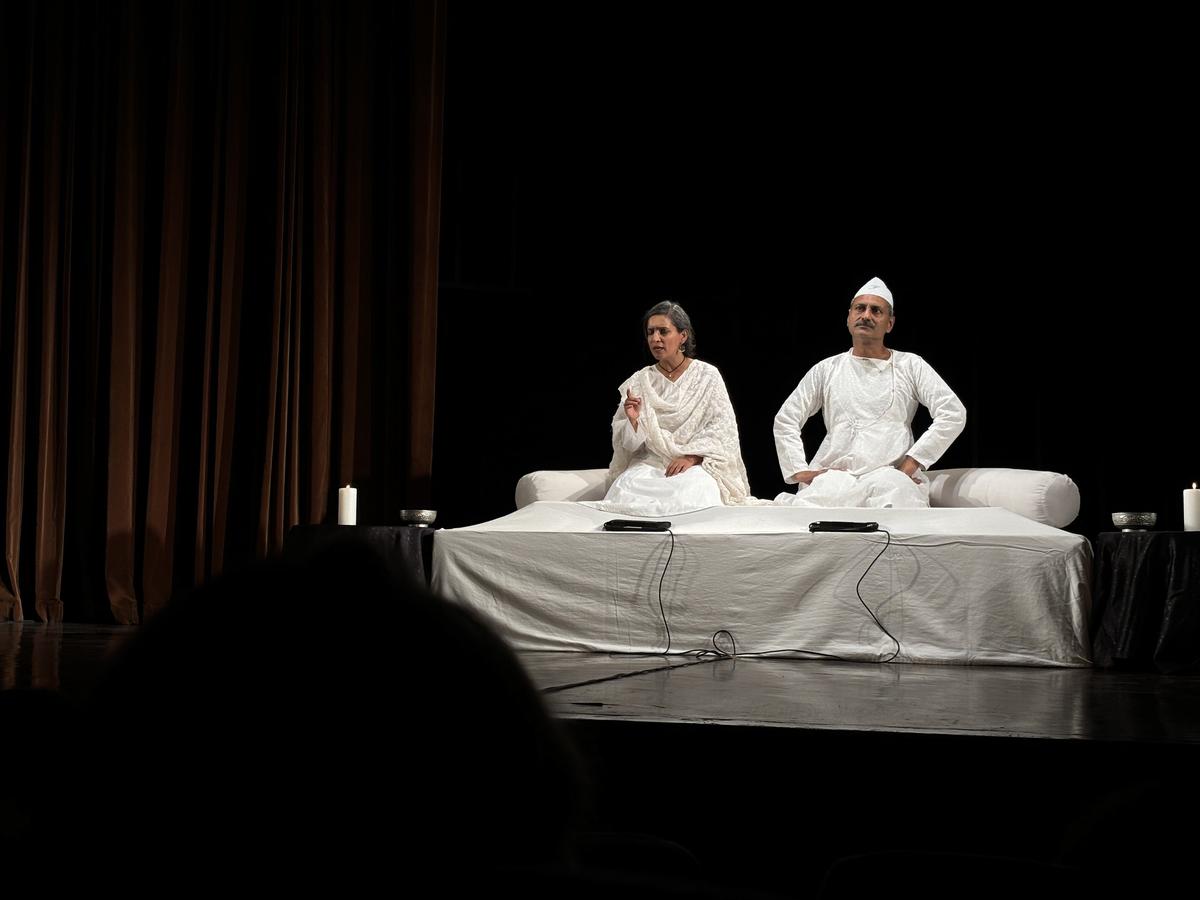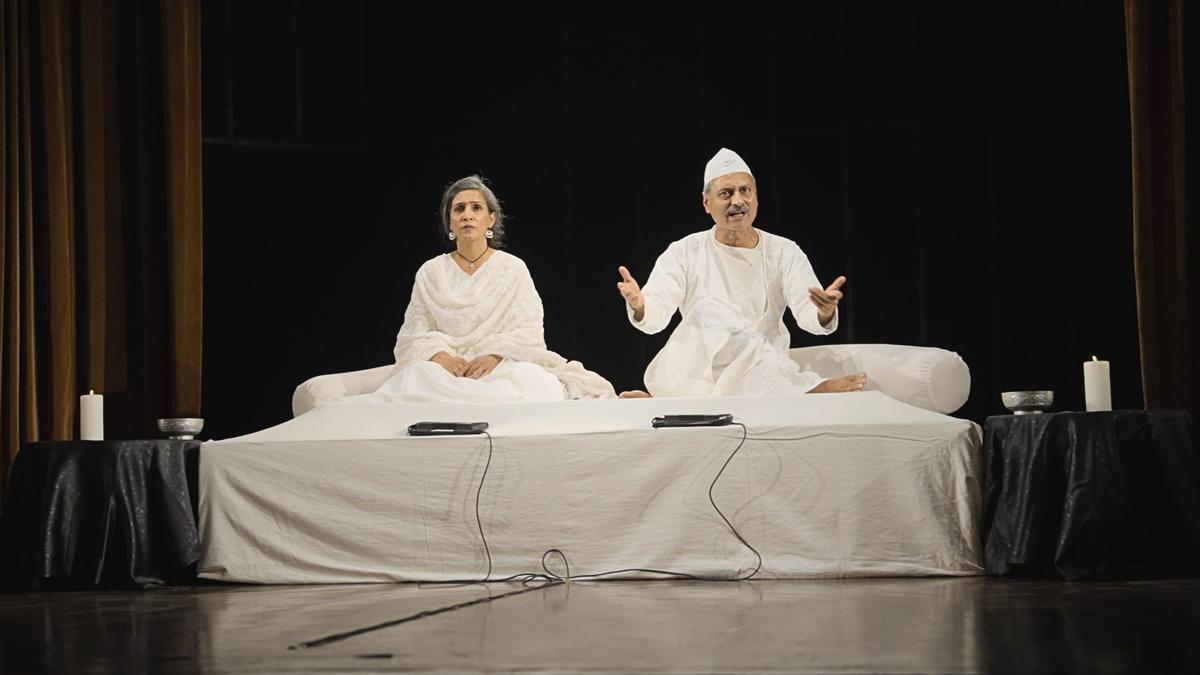sand burialThe Booker Prize (2022)-winning novel in Hindi by noted author Gitanjali Shree came alive with all its nuances when dastangos Mahmood Farooqi and Poonam Girdhani transformed it into an aural delight. Jointly presented by Rajkamal Prakashan and Dastangoi Collective at the Stein Auditorium of India Habitat Centre; the presentation was as riveting as the novel.
Dastangoi is the art of Urdu storytelling which reached the peak of its popularity during the reign of Akbar. But with the death of Mir Baker Ali, the last known exponent of this art in 1928, Dastangoi also became extinct.
The credit for the revival of this ancient art form goes to renowned Urdu literature writer Janab Shamsur Rahman Farooqi and his nephew Mahmood Farooqi. Mahmood graduated in History from St. Stephen’s College Delhi and received a Rhodes Scholarship to continue his studies in History at St. Peter’s College, University of Oxford. He restarted Dastangoi in 2005 and conceived of a modern version of the art form. Since then, he has performed thousands of shows around the world.
The specialty of Daastan Goi is that there is no support or music for its presentation. Photo Courtesy: Special Arrangement
A recipient of the Sangeet Natak Akademi’s Bismillah Khan Yuva Puraskar for Dastangoi, Mahmud trained several Dastangos, including Poonam Girdhani, and composed several new narratives or dastans for the modern stage, such as Dastan-e-Taqsim-e-Hind on Partition, Dastan-e-Chauboli from an adaptation of Vijay Dan Detha’s Rajasthani folk tale, Dastan-e-Raag Darbari based on Shrilal Shukla’s satirical novel, Mantoiyaat – a performance on the life and times of Saadat Hasan Manto and Dastan-e-Karn from the Mahabharat, a retelling of the life of the legendary Karna based on Urdu, Persian, Hindi and Sanskrit sources.
‘Dastan-e-Ret Samadhi’ was created, directed and produced by Mahmood Farooqui and produced by Delhi-based writer and film director Anusha Rizvi, whose first feature film as writer-director was acclaimed. Peepli Live.
Poonam Girdhani, who acted alongside Mehmood in ‘Ret Samadhi’, is a theatre and film actor who is diversely involved in the field of performing arts.
Geetanjali Shree said, “I am an admirer of Mahmud’s art. He has made us laugh, cry and inspires us to think. He takes threads from our shared culture and weaves a beautiful fabric from them.”
Mahmood shared the dastaan (story) behind the making of this dastaan. “When Ashok Maheshwari, the head of Rajkamal Prakashan, talked to me about this project, I was a little apprehensive. The way it is written, I found it a little challenging. The writer does not want to reveal the story easily. She wants to maintain the suspense till the end whereas dastaangoi is an art in which the story has to be revealed first. It unravels the mysteries and suspense in its flow. The challenge was to strike a balance between the two.”
There was excitement in the air when Mahmood Farooqi came on stage in his Lucknowi angarkha and duppali topi and Poonam Girdhani in her gharara, kameez and dupatta with delicate chikankari. The audience was eagerly waiting for this new endeavor. The setting was simple – a diwan covered with white chander, two gaav-pillows and on either side of the performers were placed naqqashidar (carved) silver raqabiyas (cups) filled with water.

Mehmood and Poonam take turns to narrate the story of Sand Samadhi, which revolves around a mother and daughter. | Photo Credit: Special Arrangement
Before the singer sang the bandish, like the opening alaap of a raga, Mahmood and Poonam created an aura with their imaginative inputs of Urdu and Persian ashars (couplets) and Sanskrit subhasits or shlokas of Kalidasa. They took turns to take the story forward. Sand Tombwhich revolves around two female characters, a mother and a daughter.
After her husband’s death, Maa loses interest in life and lies in bed staring at the wall. Her son, daughter-in-law and grandchildren try to convince her to get up and attend to daily chores, but she refuses. It is only when her daughter takes her home and showers her with love and care that Maa slowly begins to accept the reality of her life. She decides to cross the border and go to Lahore, a place still alive in her memories.
touching description
Mehmood and Poonam took the audience along on this journey. Their smooth pronunciation, dramatic ups and downs of voice, narration of the story with alliteration and anecdotes, and heart-touching couplets like ‘Mil hi jayega kahin dil mein yaqeen rehta hai/Woh isi sheher ki galley mein kahin rehta hai. Jiski saanson se mahkte the dar-o-baam mere/Aye makaan bol kahan ab woh makaan rehta hai.’ Their narration expressed the emotions of an 80-year-old mother trying to connect with her childhood.
In the second part, when the story reached its climax, Mehmood, with the power of his voice and facial expressions, brought alive the scenes of cruelty and bloodshed of Partition, to which Poonam responded in the same manner.
The specialty of Daastango is that there is no props or music for the performance. The artist has to create magic. Here the audience experienced the humor, suffering, pain and compassion in the novel, while the Daastango showed that words have a life of their own.
